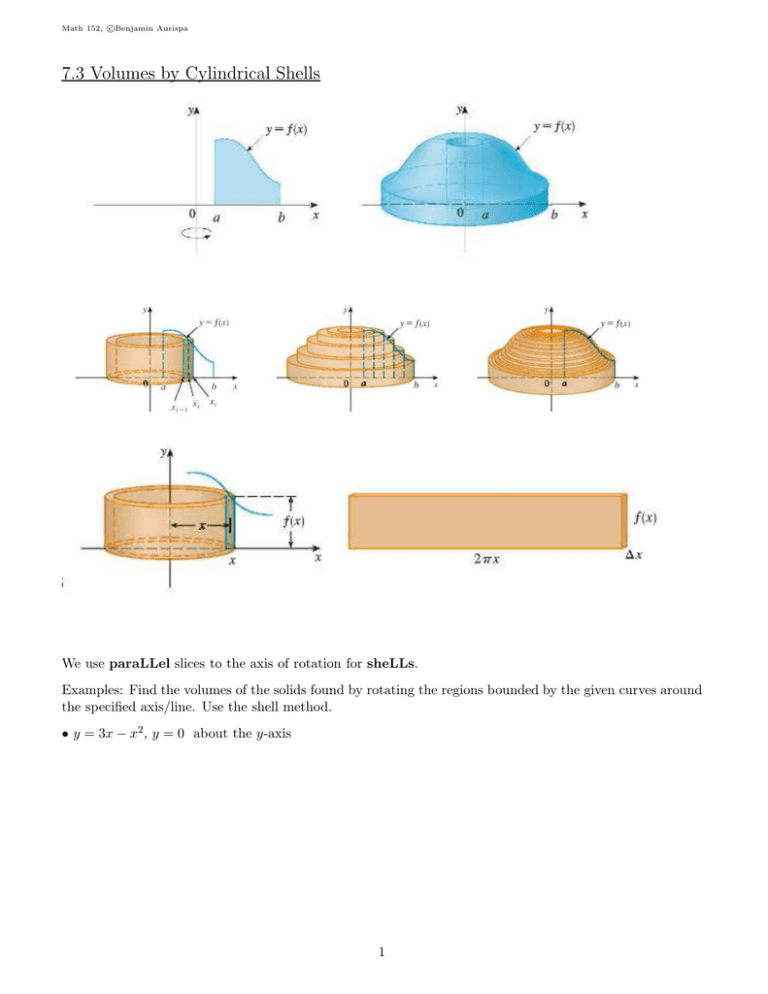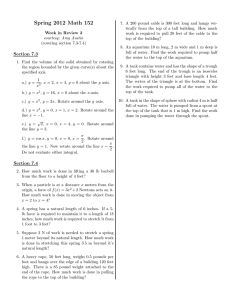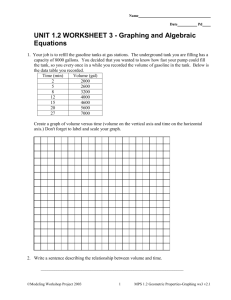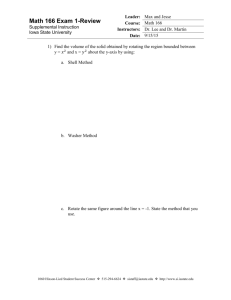Document 10504205
advertisement

c Math 152, Benjamin Aurispa 7.3 Volumes by Cylindrical Shells We use paraLLel slices to the axis of rotation for sheLLs. Examples: Find the volumes of the solids found by rotating the regions bounded by the given curves around the specified axis/line. Use the shell method. • y = 3x − x2 , y = 0 about the y-axis 1 c Math 152, Benjamin Aurispa • y = −x2 + 8x − 7, y = −x + 11 about the line x = −3 • y = x1 , x = 0, y = 2, y = 5 about the x-axis • y = x2 , y = 2x about the line y = −3. 2 c Math 152, Benjamin Aurispa •y= √ x + 2, x = 1, y = 5 about the line x = 11 • x = −y 2 + 8y − 7, x = 5 about the line y = 8 How to determine which method to use for solids of revolution if you aren’t told which method to use: 1. How do you want to slice the region up? Is it easier to do vertical or horizontal slices? Would you have to split it up into two integrals? 2. Whichever axis your slices “chop up” immediately determines whether it is a dx or dy integral. If the way you slice it doesn’t matter, is it easier to integrate with respect to x or y? Can you write all the given equations in terms of the desired variable? 3. If slices are paraLLel to axis of rotation, use sheLLs. If slices are perpendicular to axis of rotation, use disks/washers. 3 c Math 152, Benjamin Aurispa • y = x2 − 6x, y = 4x − x2 rotated around y = 9. • y = 4 − x2 bounded in the first quadrant rotated about the x-axis. 4 c Math 152, Benjamin Aurispa 7.4 Work Muy Importante for this Section: UNITS!!!! Force Distance Work SI Units Newtons (N) To convert from mass in kg to Newtons, multiply by gravity: 9.8 m/s2 Meters (m) Joules (J) 1 N·m = 1 J US Units Pounds (lb) Feet (ft) Foot-Pounds (ft-lb) If a constant force F moves an object d units, then the work done is W = F d. Example: How much work is done in lifting a 40 kg object to a height of 5 m? What happens when force is not constant? Suppose an object is moved from x = a to x = b by a force f (x) that varies depending on where the object is. Then, the work done by the force in moving the object from a to b is given by W = Z b f (x) dx a Example: When a particle is x ft from the origin, a force of f (x) = √ much work is done in moving the object from x = 1 to x = 8 ft? 1 pounds acts on the object. How x+4 Spring Problems Hooke’s Law: The force required to hold a spring x units stretched beyond its natural length is proportional to x. In other words, f (x) = kx for some positive constant k, which we call the spring constant. Example: A spring has a natural length of 20cm. A force of 60 N is required to hold the spring stretched to a length of 50cm. How much work is done in stretching the spring from a length of 30cm to a length of 90cm? 5 c Math 152, Benjamin Aurispa Example: Suppose the work needed to stretch a spring from its natural length to a length of 5 ft beyond its natural length is 30 ft-lb. 1. How much work is done in stretching the spring from 3 ft beyond its natural length to 120 in beyond its natural length? 2. How far beyond its natural length will a force of 60 lb keep the spring stretched? Rope Pulling Problems Example: A 40 ft rope that weighs 120 lbs hangs off a 100 ft cliff. How much work is needed to pull the whole rope to the top of the cliff? Example: A rope that weighs 4 lb/ft is being used to pull a 50 lb bucket up a 70 ft well. How much work is done in lifting the bucket up the first 30 ft? 6 c Math 152, Benjamin Aurispa Water Pumping Problems • A cylindrical tank has a radius of 4 m. The tank is 5 m tall and is filled with water. How much work is required to pump all the water out of the tank? Use the fact that the density of water is ρ = 1000 kg/m3 . In general: • An inverted conical tank is filled with water. The tank has a height of 8m and a radius of 3m. How much work is required to pump all the water out of the tank? Use the fact that the density of water is ρ = 1000 kg/m3 . 7 c Math 152, Benjamin Aurispa • A trough is 10 ft long and has ends which are isosceles triangles with height 5 ft and width 4 ft. The trough has a spout at the top of the tank with height 1 ft. The trough is filled with water to a depth of 3 ft. How much work is required to pump all of the water out of the tank? Use the fact that the density of water is ρg = 62.5 lb/ft3 . • A spherical tank with radius 6 m is half-filled with a liquid that has a density of ρ = 200 kg/m3 . The tank has a 2 m spout at the top. Find the work needed to pump all of the liquid out of the tank. • (If time) A trough is 20 m long with semicircular ends that have radius 6 m. If the tank is filled with water to a depth of 5 m, set up the integral to calculate how much work is needed to pump all the water out of the tank. Use the fact that the density of water is ρ = 1000 kg/m3 . 8 c Math 152, Benjamin Aurispa 7.5 Average Value of a Function The average value of a function on an interval [a, b] is given by 1 fave = b−a Example: Find the average value of f (x) = sin Example: Find the average value of f (x) = x 3 Z b f (x) dx a on the interval [π, 2π]. ln 3x on the interval [1, 5]. x Example: Find the value(s) of b such that the average value of f (x) = 3x2 + 6x on the interval [0, b] is 10. 9 c Math 152, Benjamin Aurispa Mean Value Theorem for Integrals: If f is continuous on [a, b], then there exists a number c on this interval such that Z b 1 f (x) dx f (c) = fave = b−a a Example: Find the average value of f (x) = 1 on the interval [1, 5]. x2 Find the value(s) of c such that f (c) = fave . 10







